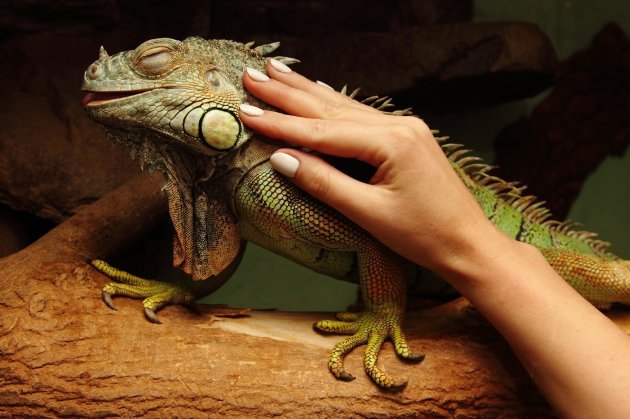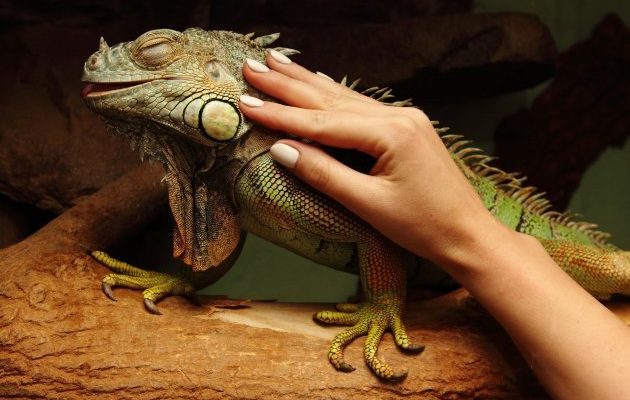
Just like people, iguanas have their own vibes and needs. Some are low-maintenance, while others require a bit more TLC. Before you dive headfirst into the world of iguana ownership, it’s important to know which species might be the best fit for your lifestyle. So, let’s take a closer look at the top five iguanas to keep as pets.
1. Green Iguana
The green iguana is probably the most well-known pet iguana. They’re the classic choice for many first-time reptile owners. These creatures can grow up to 6 feet long, so they need a spacious enclosure. Think of a green iguana as the friendly giant of the lizard world.
These iguanas thrive in bright light and require a good UVB source. It’s like giving them a little slice of the sun to bask in! They eat a mostly herbivorous diet, with greens and fruits being their favorites. You might be wondering if they’re cuddly. Well, they’re more likely to hang out on your shoulder than curl up in your lap. But their fascinating behavior and vibrant colors may keep you entertained for hours!
Care Tips for Green Iguanas
– Enclosure Size: Aim for at least a 6-foot tall cage. These guys need room to climb!
– Diet: Leafy greens like collard greens and dandelion greens are great staples. Avoid high-oxalate foods like spinach.
– Hydration: Mist your iguana regularly to keep its skin healthy and hydrated.
2. Lesser Antillean Iguana
Next up is the lesser Antillean iguana, often overshadowed by its green cousin but equally charming. These iguanas are smaller, reaching around 3 feet in length, making them a better option for those with limited space. They’re native to the Caribbean and have beautiful, vibrant colors that can range from green to pastel shades.
You might appreciate that they’re generally a bit more laid-back compared to other species. This gives them a friendly disposition that can make them easier to handle. Lesser Antillean iguanas are also herbivores and thrive on a diet of leaves and fruits. Just be mindful that they can be a bit shy at first. With some patience, they can become quite affectionate!
Care Tips for Lesser Antillean Iguanas
– Habitat: Provide plenty of climbing opportunities! Branches and hiding spots are essential.
– Dietary Needs: A mix of leafy greens, fruits, and even edible flowers can help maintain their health.
– Handling: Give them time to adjust before attempting to hold them.
3. Rhinoceros Iguana
If you want an iguana that makes a statement, the rhinoceros iguana might just be for you. Known for the distinct, horn-like structures on their snouts, they have a rugged look that many find fascinating. They’re a bit on the larger side, as they can grow up to 4 feet long, but their calm demeanor often makes them more manageable.
These iguanas hail from the Caribbean as well and thrive in warmer climates. Unlike some other species, they are known for their relatively docile nature, making them great companions for experienced reptile owners. Their diet can be more varied, including fruits and veggies, with the occasional protein source.
Care Tips for Rhinoceros Iguanas
– Temperature Control: Keep their environment warm, with basking spots around 95°F.
– Diet: Offer a balance of fruits, greens, and safe commercial iguana food.
– Socialization: They enjoy being around their humans. A little daily interaction can go a long way!
4. Blue Iguana
The blue iguana is a stunning sight to behold! With its bright blue coloration, it’s like having a piece of the Caribbean right in your home. These iguanas can grow up to 5 feet long, so you’ll need to consider space before bringing one home. They’re a bit more sensitive than other species but can also form strong bonds with their owners.
Due to their relatively high conservation status, it’s essential to ensure you’re sourcing your blue iguana properly. They require special care and a carefully controlled environment to thrive. Training and socializing them early on can help reduce some of the stress they might feel in unfamiliar situations.
Care Tips for Blue Iguanas
– Lighting Needs: Just like the others, they need UVB lighting for at least 12 hours a day.
– Diet: Focus on leafy greens, fruits, and occasional flowers.
– Handling: Start handling slowly to avoid stress, giving them time to adjust to their new environment.
5. Spiny-Tailed Iguana
Finally, we have the spiny-tailed iguana, often called the black spiny-tailed iguana or Ctenosaura pectinata. These iguanas have a unique personality and can even display some feistiness, which makes them a bit more entertaining. They’re smaller, usually topping out around 3 feet in length, making them easier to care for in terms of space.
These iguanas thrive on sun and warmth, and they love to dig. You might consider providing a sandy substrate in their enclosure for them to burrow in. They’re primarily herbivores, but they’ll also enjoy insects on occasion. Their unique demeanor and playful nature can make them a delightful companion.
Care Tips for Spiny-Tailed Iguanas
– Enclosure: Ensure they have both vertical and horizontal space to climb and explore.
– Heat and Light: They also require heat and UVB lighting, just like the others, to stay healthy.
– Diet Varieties: Mix it up with greens, veggies, and the occasional bug for some protein.
In conclusion, choosing the right iguana as a pet can be a fantastic experience. Each species has its own charm, quirks, and needs. Whether you opt for the classic green iguana or the eye-catching blue iguana, they can bring a breath of fresh air—well, maybe not literally!—to your home. Remember to research thoroughly and consider your living situation, as each iguana comes with its own care requirements. Happy iguana parenting!

